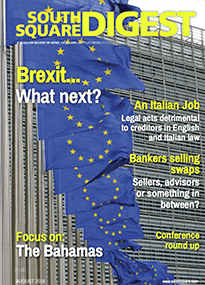

Two recent cases in the Chancery Division provide reminders of fundamental procedural principles says Jeremy Goldring QC
Introduction
On the night before trial, the other side serves reams of new evidence, both witness statements and documents, defying the timetable and throwing careful preparation into disarray. The natural and immediate reaction, after vehement swearing at the computer screen, is to do everything possible to keep it out, so that the long planned strategy for trial can be implemented. One might call it the temptation of the short cut. The next morning, armed with the CPR, the judge is persuaded not to permit the other side to use its late evidence and the trial proceeds, culminating in victory. But Barons Bridging Finance 1 Limited v. Barons Finance Limited [2016] EWCA Civ 550, a recent decision Court of Appeal decision demonstrates that the natural reaction may well not be the right one 1. Often it will be better to deal with the substance of the new material on its merits, if possible within the existing timetable for trial, or (if that is impractical) following an adjournment. The danger is that a victory at first instance decision may turn out to be pyrrhic as the Court of Appeal sets aside the judgment on the basis that the trial was not fair. In Barons Bridging Finance, the liquidator of a company in business as an unlicensed moneylender brought a claim in the Chancery Division seeking to set aside a deed of assignment of a portfolio of debts under s 127, s 238 and s 423 of the Insolvency Act 1986. The deed purportedly bore a date prior to the commencement of the liquidation. The third defendant (Dharam Gopee) was an experienced litigant in person, who conducted the defence of all three defendants. The liquidators made two main allegations. The first was that, contrary to the date it bore, the deed was in fact executed after presentation of the winding up petition, so that s 127 was engaged. i.e. the document had been fraudulently backdated. The second was that the portfolio of assigned debts was worth more than was paid for it, so that in any event s 238 and s 423 applied. The defendants denied both the backdating and the allegation of undervalue. In particular the value of the debts was undermined because the majority was unenforceable due to lack of compliance with the Consumer Credit Act 1974.
The trial
On the first day of the trial, the defendants produced an application for disclosure by the liquidator of documents said to be relevant to the low value of the debts generally, because of their unenforceability. On the second day, Mr Gopee sought to rely on a four-page witness statement, with an exhibit of 104 pages, giving an explanation as to why a particular assigned debt (on which the liquidator specifically relied) was valueless. The deputy judge rejected both of the defendants’ applications. As to the second he “concluded that no good reason had been given for the delay, nor for the failure to seek an extension, that it would be unfair to the liquidator to have to deal with this evidence today and that an adjournment would be costly for the liquidator and unfair to other litigants.” While Mr Gopee presented the defendants’ case, he did not give evidence in chief, nor was he cross-examined. As to the merits, the deputy judge accepted the liquidator’s case. The deed was entered into after the commencement of the winding up. In any event, it was a transaction at an undervalue and one defrauding the Company’s creditors. In reaching those conclusions, the judge relied, amongst other things, on adverse inferences based on a lack of evidence and explanation provided by the defendants. Referring to Wisniewski v. Central Manchester Health Authority [1998] PIQR 3242, he said: “The burden is on [counsel for the liquidator] to prove her case, but if she provides prima facie evidence, then it may be proper to draw an adverse inference from Mr Gopee’s failure to put in a witness statement to the contrary.” Later in the judgment, the deputy judge returned to the theme: “The liquidator has produced a schedule of debts owned by the Company. Mr Gopee was asked to verify this and failed to do so. I am satisfied that I should apply the principle in the old case of Armory v. Delamirie (1722) 1 Strange 505, i.e. that I should resolve any evidential doubts against Mr Gopee. The liquidator says, and I accept, that the schedule shows outstanding debts of some £373,000, which includes £40,000 which was the original sum lent to Mr Kelly. Mr Gopee says that some of these debts are contracts which are void or unenforceable under the Consumer Credit Act. He has produced no evidence to substantiate this. On the contrary, the evidence is that he has pursued the hapless debtors for payment. It does not lie in his mouth to assert that these debts are worthless. Once again, I apply Armory v. Delamirie.”
The appeal to the Court of Appeal
Matters looked very different from the Court of Appeal’s perspective. Gloster LJ (with whom Kitchin LJ agreed) concluded that the defendants had not received a fair trial. The Court of Appeal therefore set aside the judgment, and remitted it to the Chancery Division for a rehearing. Gloster LJ set out a number of ways in which the proceedings, which after all alleged fraud, had gone wrong. Mr Gopee should have been permitted to give evidence during the trial as a witness giving his evidence, not as a litigant advocate presenting submission under stress: “In circumstances where the defence (supported by Mr Gopee’s statement of truth) and his witness statements in support of his applications for disclosure, denied both the backdating and the transfer at an undervalue, and Mr Gopee, albeit an experienced litigant, was acting as a litigant in person, it was in my judgment wrong for the judge not to have allowed him to have given evidence. The judge should have allowed Mr Gopee to go into the witness box and give evidence in chief in order to support his defence and be subjected to cross-examination; alternatively the judge should have accepted his additional witness statements as evidence and allowed him to be cross-examined on them.” Mr Gopee should also have been permitted to rely on his late evidence: “There was nothing in the exhibits to the further witness statements … which the liquidators should not have been in a position to deal with either immediately or overnight. If a lengthier adjournment had been required, no doubt an appropriate order could have been made in relation to the costs of any such adjournment.” In any event, the liquidator should have disclosed additional information about the value of the Company’s loan book, which undermined his allegation of a transfer at an undervalue. As a result of these various failings, the trial before the deputy judge was unfair. As Gloster LJ put it: “Accordingly, the judge’s failure to permit Mr Gopee to give evidence, and further the former’s decision to draw serious adverse inferences from the fact that Mr Gopee had not done so … ,were in my view wrong in principle because they resulted in the appellants having an unfair trial. Not only did the appellants not have a proper opportunity to present their case but they also suffered the disadvantage of that failure being used evidentially against them. In my judgment, whatever view the judge took of Mr Gopee’s experience as a litigant, the judge nevertheless should, in all the circumstances of the case, have given him, as a litigant in person, a proper opportunity to give evidence. He should also have given serious consideration as to whether there was any documentation within the possession of the liquidator which might have borne on the recoverability of the loans and accordingly the value of the loan book as at the date of the assignment.” In short, the Court of Appeal’s careful and detailed analysis of the proceedings at first instance led it to the conclusion that the deputy judge had been too easily persuaded of the defendants’ fraud (at [46], with emphasis added): “In my view because, as the reported judgments against him and his companies make clear (some of which I have been involved in refusing permission to appeal to Mr Gopee and his companies), Mr Gopee has had, to put it mildly, somewhat of a chequered career in the courts in relation to his conduct of the Company and his other associated money lending companies, the judge mistakenly found it all too easy to infer fraud against Mr Gopee and the other appellants. That is exemplified by the judge’s statement, at paragraph 12 of the judgment, that “Given that this is a case of fraud for the benefit of the various companies controlled by Mr Gopee, it would be difficult to imagine a less meritorious case.” In my judgment, that comment demonstrates the lack of objective impartiality which the judge failed to bring to his analysis of this case. That assertion is no more than conclusory.” Harb v. Abdul Aziz Bin Fahd Another recent example of an appeal succeeding in the Chancery Division on the grounds that the trial was unfair, on the basis that the defendants’ case was not properly dealt with, is Harb v. Abdul Aziz bin Fahd [2016] EWCA Civ 556, a case which has achieved some notoriety. 3 That case was an appeal against an order in favour of a bankrupt, against Prince Abdul Aziz bin Fahd, a member of the Saudi royal family and son of the late King Fahd, on the bankrupt’s claim (assigned by her trustee) to enforce the performance of a contract to pay her the sum of £12 million and to procure the transfer to her of the title to two properties in Cheyne Walk. The judgment was held to be unfair by the Court of Appeal because of a lack of reasons in the judgment, the judge being criticised because, “in effect, he took a short cut” in his evaluation of the factual evidence (at [38]). The Master of the Rolls said (at [39], emphasis added): “Our system of civil justice has developed a tradition of delivering judgments that describe the evidence and explain the findings in much greater detail than is to be found in the judgments of most civil law jurisdictions. This requires that a judgment demonstrates that the essential issues that have been raised by the parties have been addressed by the court and how they have been resolved. In a case (such as this) which largely turns on oral evidence and where the credibility of the evidence of a main witness is challenged on a number of grounds, it is necessary for the court to address at least the principal grounds. A failure to do so is likely to undermine the fairness of the trial. The party who has raised the grounds of challenge can have no confidence that the court has considered them at all; and he will have no idea why, despite his grounds of challenge, the evidence has been accepted. That is unfair and is not an acceptable way of deciding cases.” In the same judgment, the Court rejected a further ground of appeal to the effect that the judge displayed apparent bias: see [73] to [77]. Having set out the legal test from Porter v. Magill [2002] 2 AC 357, at [103] (whether the fair-minded observer, having considered the facts, would conclude that there was a real possibility that the tribunal was biased), the Court, in rejecting the challenge notwithstanding strong criticism of the judge’s conduct, emphasised two important points. At [69] to [71], the Court dealt made its first point: “First, the opinion of the notional informed and fair-minded observer is not to be confused with the opinion of the litigant. The “real possibility” test is an objective test. It ensures that there is a measure of detachment in the assessment of whether there is a real possibility of bias: see Helow v Secretary of State for the Home Department [2008] UKHL 62, [2008] 1 WLR 2416 at para 2 per Lord Hope. As Lord Hope also said in Porter v Magill at para 103, the “real possibility of bias” test “is in harmony with the objective test which the Strasbourg court applies when it is considering whether the circumstances give rise to a reasonable apprehension of bias” … the litigant is not the fair-minded observer. He lacks the objectivity which is the hallmark of the fairminded observer. He is far from dispassionate. Litigation is a stressful and expensive business. Most litigants are likely to oppose anything that they perceive might imperil their prospects of success, even if, when viewed objectively, their perception is not well-founded.” At [72], the Court made its second point: Secondly, the informed and fairminded observer is to be treated as knowing all the relevant circumstances and it is for the court to make an assessment of these: see Competition Commission v BAA Ltd and Ryanair Ltd [2010] EWCA Civ 1097 per Maurice Kay LJ at paras 11 to 13 and the authorities cited there. … It was held in Virdi v Law Society [2010] EWCA Civ 100 that the hypothetical fair-minded observer is to be treated as if in possession of all the relevant facts and not only those that are publicly available. Stanley Burnton LJ gave a number of reasons for this conclusion at paras 43 to 48 of his judgment. This reasoning is binding on this court. In any event, we are satisfied that it is correct.”
Conclusion
Neither Barons Bridging Finance nor Harb says anything new or surprising, but both illustrate that the temptation of the short cut is a dangerous one, whether for advocate or judge. What may appear to be a straightforward and practical procedural approach at first instance may look different with hindsight. The risks to the losing party’s basic right to a fair trial, especially where the losing party is accused of fraud or is a litigant in person, may be more obvious from the Court of Appeal’s perspective than during the roughand-tumble of trial.
1/. The judgment was handed down on 14 July 2016.
2/. In that case, at 340, Brooke LJ said: “(1) In certain circumstances a court may be entitled to draw adverse inferences from the absence or silence of a witness who might be expected to have material evidence to give on an issue in an action. (2) If a court is willing to draw such inferences they may go to strengthen the evidence adduced on that issue by the other party or to weaken the evidence, if any, adduced by the party who might reasonably have been expected to call the witness. (3) There must, however, have been some evidence, however weak, adduced by the former on the matter in question before the court is entitled to draw the desired inference: in other words, there must be a case to answer on that issue. (4) If the reason for the witness’s absence or silence satisfies the court then no such adverse inference may be drawn. If, on the other hand, there is some credible explanation given, even if it is not wholly satisfactory, the potentially detrimental effect of his/her absence or silence may be reduced or nullified.
3/. The judgment of the Court, which consisted of Moore-Bick and Mcfarlane LJJ, in addition to the Master of the Rolls, was handed down on 16 June
2016.







![Brake & Anor v The Chedington Court Estate Ltd [2023] UKSC 29](https://southsquare.com/wp-content/uploads/2024/02/Brake-Anor-scaled-e1728649908896.jpeg)








![New Judgment: Re Argentex LLP [2025] EWHC 3125 (Ch)](https://southsquare.com/wp-content/uploads/2025/06/alejandro-pohlenz-gYbOFTwcJx4-unsplash-scaled.jpg)
